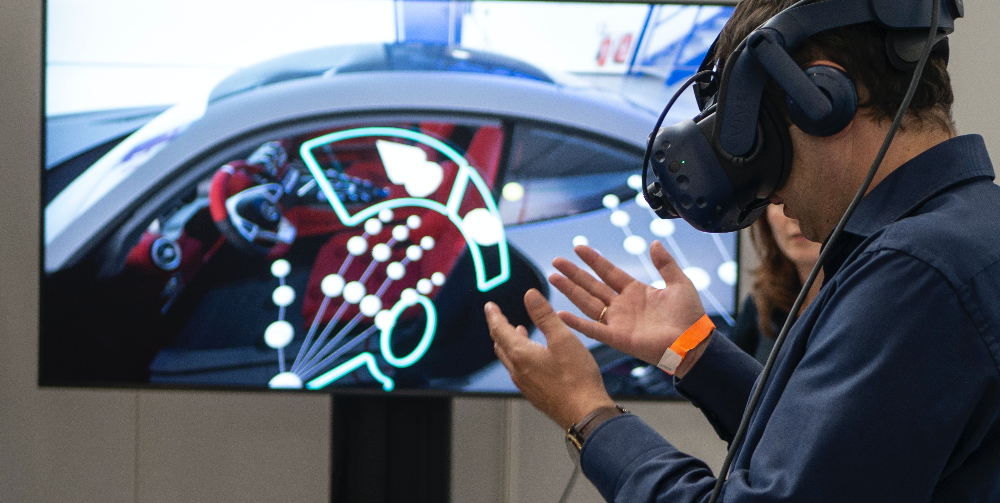The global automotive VR market will grow at an annual rate of 45 percent, reaching more than $14 billion by 2027. – Fortune 500 Insights Report
This statistic highlights the increasing use of virtual reality training as more dealerships are implementing this technology for multiple reasons, from improving the learning experiences of their employees, to meeting the skills shortage faced by the automotive industry.
The COVID-19 pandemic exacerbated this situation as there is a growing demand for skilled workers and technicians as automotive is one of the fastest-growing industries in the world.
In addition to innovations such as autonomous cars and electric vehicles, the sector is actively seeking ways to keep up with current trends and market demands.
As expected, the automotive sector is adopting virtual reality technology and experiencing significant advantages. Notably, one area where VR is garnering attention is training.
From helping to bridge the skills gap, to providing a more interactive training experience for employees, more car brands are implementing this approach.
In this blog post, we’ll be exploring the importance of virtual reality training in the automotive industry and 5 examples of brands implementing this technology across their own teams.
The Importance of Virtual Reality Training in the Automotive Industry
The automotive sector relies on various skilled specialists to make cars efficiently and to ensure the highest quality and safety standards.
VR and other advanced technologies are now helping the automotive industry in several ways. Firstly, these technologies are becoming increasingly important due to the shift towards greener transportation options, such as electric cars.
To meet this shift, automakers need to develop more efficient batteries and alter their current production processes, requiring specialised expertise.
As a result, there is a growing demand for skilled workers who can produce components like electric motors and batteries, however, the industry is struggling to find enough qualified professionals.
This shortage of specialists poses a challenge because hiring, training, and retaining the right people is crucial. Moreover, high employee turnover rates can negatively impact customer service, especially in the luxury car market. It can lead to disruptions in customer relationships and frustrations as customers have to start over with new sales representatives.
To address this challenge and to ensure the success of your dealership, embracing virtual reality training is key.
This technology allows you to efficiently train existing employees to help bridge the EV technician shortage, whilst also delivering a better, more immersive learning experience for all employees. Essentially, virtual reality training solves two of the biggest challenges:
- Bridging the skills gap
- Motivating and engaging sales teams
What Are the Benefits of Using Virtual Reality Training for Employees?
As noted above, VR training can significantly improve the learning experience and therefore the overall performance of employees.
When employees are engaged in the training, it increases the likelihood that they will be invested rather than being passive. In turn, they will absorb more of the information and be better trained as a result, improving the level of customer service they can deliver.
Below are some advantages of using VR training for your team:
- Immersive learning environment: VR provides a highly immersive learning environment that simulates real-world scenarios.
- Safe practice: VR offers a risk-free way for employees to practice and refine their skills. They can make mistakes and learn from them without any real-world consequences.
- Cost-effective: While the initial investment in VR technology can be significant, it often proves cost-effective in the long run. VR eliminates the need for expensive physical training equipment and materials, as everything is simulated digitally.
- Customised learning: VR training can be tailored to the specific needs and skill levels of individual employees.
- Increased engagement: VR training captivates employees’ attention and keeps them engaged throughout the learning process. It can be easy for learners to get distracted but VR keeps employees actively participating to complete their training modules.
- Enhanced soft skills: VR can also be used to develop soft skills such as communication, teamwork, and leadership.
Instead of standard classroom training where employees might be sitting listening to someone talk for a few hours, virtual reality training requires their active participation and can make learning more enjoyable.

Example 1: BMW
The renowned automotive company, BMW, has been using virtual reality (VR) since the 1990s, and their commitment to harnessing this technology has remained unwavering.
Initially, BMW used VR for design and prototyping purposes. However, their use of VR has evolved to include employee training. The primary goal is to provide managers with immersive virtual training experiences, allowing them to transfer their knowledge to the operational staff.
The training curriculum covers a wide range of topics, including guidance on optimising factory layouts for lean production, ensuring workplace safety, and mastering the assembly of new products.
Each VR training program is structured into three areas: workplace planning, training and qualification, and a comprehensive comparison of component and design data.
BMW reports that this approach empowers employees to learn at their own pace, fostering a high level of commitment and ultimately resulting in increased operational efficiency.
These training modules are developed using “Unreal Engine 4,” a renowned platform for creating hyper-realistic VR simulations.
After each training session, BMW conducts surveys to fine-tune the training content. This approach enables BMW to address individual areas of performance improvement effectively.
Looking ahead, BMW envisions a future where VR (and AR) will seamlessly fit into every step of their processes, from design and production to maintenance.
Example 2: Audi
Audi’s brand logistics team has introduced a Virtual Reality (VR) Software Development Kit (SDK). This means that Audi’s trainers who have IT knowledge can create their own training modules instead of relying on programmers which is time-consuming and complex.
With the aim of democratising virtual training for a range of employees in the future, a team of five individuals from different departments has collaboratively created a Virtual Reality Software Development Kit (SDK)—essentially, a toolbox for constructing virtual-reality training courses.
Project manager Mirko Göres from Audi Brand Logistics explained, “With the help of easy-to-use menu navigation, the trainer will be able to select the desired work steps and combine them.” It is no longer necessary to work directly in the program code.
Recent developments have seen apprentices from Audi’s Ingolstadt plant logistics department embracing this virtual modular approach to understand the so-called “pick-by-light” process at the training center.
When picking components, a light signal shows the employee the required articles and their quantity directly at the respective removal point. For the new VR training, an authentic workstation has been recreated in great detail. Equipped with high-resolution 3D glasses and wielding two controllers, trainees can navigate freely within this virtual workspace, practicing their skills through various work routines based on diverse work orders.
“Virtual-reality training is very popular with our employees,” said trainer Florian Kunz from the training center in Ingolstadt. “The gamification approach is fun, so it also improves the learning progress. If a trainee performs the tasks correctly, he or she receives points. In this way, the trainee learns the way through different levels, comparable to a video game.”

Example 3: Volkswagen
Headquartered in Germany and with a global presence, Volkswagen operates across nearly 120 production facilities and boasts a workforce exceeding 600,000 employees.
When it comes to training, employees are often faced with the inconvenience of travelling to attend training programs, which can disrupt the overall learning experience. Consequently, Volkswagen set out to harness the power of virtual reality (VR) to streamline their training courses and to improve staff efficiency.
Through VR simulations, employees can engage in different tasks, such as door installation or brake assembly. Beyond this training, Volkswagen has also developed simulations for customer service and orientation programs for new hires.
During these simulations, a supervisor is on hand to offer guidance and assistance. This immersive approach not only heightens training effectiveness but also allows for thorough evaluation and continuous improvements.
Volkswagen has also established a virtual reality hub known as the “Digital Reality Hub.” Here, employees can interact with the hub by utilising HTC Vive VR headsets and two controllers.
The Digital Reality Hub comprises virtual meeting spaces, training modules, and knowledge bases, ensuring that every employee has access to virtual reality training and a wealth of knowledge resources.
Example 4: Mercedes
Mercedes-Benz uses VR and AR technology within its training initiatives, improving the learning experience for its workforce, and ensuring they have the right skills and knowledge to provide exceptional service.
All staff members have access to the Mercedes-Benz Global Training platform, which offers an extensive range of courses covering the knowledge and competencies essential for their roles.
Among these course modules are immersive VR and AR experiences, providing hands-on training in diagnosing technical issues and handling customer service inquiries effectively.
For instance, in the case of the new-generation A-Class, the sales team underwent specialised training through the Mercedes-Benz Global Training Experience. This program featured presentations on the latest models and technological advancements.
To improve this training event, IJsfontein and Wegesrand-Expert-Network collaborated to design and develop a mixed-reality experience. This approach enables participants to explore the new Mercedes-Benz A-Class and gain insights into its latest features.
Example 5: Toyota
Toyota has integrated virtual reality (VR) technology into its operations, leveraging it for swift vehicle ergonomics evaluation and design validation.
Additionally, the use of the HoloLens 2 headset has been instrumental in providing immersive training experiences and on-the-job work instructions.
Toyota’s technicians wear headsets, enabling them to access wire harness diagrams, connect with remote experts, follow inspection procedures, and acquire in-depth knowledge about new car features.
Going beyond this, the Japanese automaker has created virtual workspaces, facilitating departmental participation in meetings and events using avatar representations.
In February, Toyota collaborated with Yahoo to launch a mobile augmented reality experience—a blend of marketing and consumer research. This initiative allows prospective buyers to explore, customise, and even test drive the 2023 Crown model.
Prior to this, Toyota had ventured into WebAR product launches and showrooms for both the Toyota and Lexus brands, illustrating a commitment to innovative approaches in engaging customers.
Watch the video below to learn more about how Toyota is using VR to train and upskill both current and new employees. In the interview, Dave Kleiner, from Toyota’s Applied Technology Research Lab, talks about the benefits of VR including how the software empowers frontline workers to deliver faster training and how it can be scaled up.
5 Winning Examples of Virtual Reality Training In the Automotive Industry
Virtual reality training in the automotive industry is constantly evolving and growing in popularity. Many car brands understand and embrace the advantages this technology can bring, especially in such a competitive market.
Two of the biggest challenges of any dealership are:
- Having skilled employees
- Having a motivated and engaged workforce
These are two areas where virtual reality training can be significantly advantageous, as through different modules, both new and existing employees can learn the skills they need to excel in their role.
Furthermore, through immersive and interactive modules, employees are much more engaged in their learning as they can learn different skills and processes in a risk-free, enjoyable way. They can see firsthand how to do different things, and get feedback in real time. It can also be used to assist employees in visualising the virtual selling experience to make their customer service even better. The benefits are endless.
At JBA, we’re committed to delivering the highest standards of training. We know that the success of your dealership relies on your people, that’s why we craft customised training solutions to address your specific needs. Whether it’s up skilling current employees or finding ways to empower and engage your sales team, we’re here to help. Get in touch for more information.



